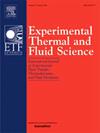Swirling flow and spray atomization interactions in a swirl cup airblast fuel injector: Venturi outlet angle
IF 3.3
2区 工程技术
Q2 ENGINEERING, MECHANICAL
Experimental Thermal and Fluid Science
Pub Date : 2025-09-22
DOI:10.1016/j.expthermflusci.2025.111622
引用次数: 0
Abstract
Swirl cup airblast fuel injectors are critical components in modern low-emission gas turbine combustors. Understanding the underlying physics of the interaction between fuel spray and complex swirling airflow is crucial for optimizing injector performance. This study investigates the influence of Venturi outlet angles (15°, 25°, and 35°) on airflow field and spray atomization dynamics. Advanced optical diagnostics, including high-speed shadowgraph, Phase Doppler Particle Analyzer (PDPA), Particle Imaging Velocimetry (PIV), and Planar Mie scattering (PMie), were employed to quantify flow-spray interactions under controlled fuel flow rates (2.0–4.0 kg/h) and 3 % relative air pressure drop. Results demonstrate that the Venturi outlet angle significantly modulates primary atomization. Increasing the angle from 15° to 35° reduces liquid film length by 69.2 % due to enhanced gas–liquid shear stress. Moreover, larger angles amplify central toroidal recirculation zone (CTRZ) reverse velocity (−1.2 to −6.8 m/s), intensifying droplet entrainment and reducing Sauter Mean Diameter (SMD) by 30.9 %. These findings highlight that Venturi angles > 25° optimize atomization by balancing shear-driven breakup and recirculation-enhanced mixing, providing critical insights for designing fuel injectors with improved combustion stability and emission performance.
旋流杯式喷风喷油器中的旋流与喷雾雾化相互作用:文丘里出口角
旋流杯式鼓风喷油器是现代低排放燃气轮机燃烧室的关键部件。了解燃油喷射与复杂旋转气流之间相互作用的基本物理原理对于优化喷油器性能至关重要。本文研究了文丘里出口角(15°、25°和35°)对气流场和喷雾雾化动力学的影响。采用先进的光学诊断技术,包括高速阴影成像、相位多普勒粒子分析仪(PDPA)、粒子成像测速仪(PIV)和平面米氏散射(PMie),量化控制燃油流量(2.0-4.0 kg/h)和3%相对空气压降下的流动-喷雾相互作用。结果表明,文丘里出口角对一次雾化有明显的调节作用。将夹角从15°增加到35°,由于气液剪切应力的增强,液膜长度减少了69.2%。此外,更大的角度放大了中心环形再循环区(CTRZ)的反向速度(- 1.2 ~ - 6.8 m/s),强化了液滴夹带,使井眼平均直径(SMD)减小了30.9%。这些研究结果表明,文丘里角25°通过平衡剪切驱动的破碎和再循环增强的混合来优化雾化,为设计具有更好燃烧稳定性和排放性能的喷油器提供了重要见解。
本文章由计算机程序翻译,如有差异,请以英文原文为准。
求助全文
约1分钟内获得全文
求助全文
来源期刊

Experimental Thermal and Fluid Science
工程技术-工程:机械
CiteScore
6.70
自引率
3.10%
发文量
159
审稿时长
34 days
期刊介绍:
Experimental Thermal and Fluid Science provides a forum for research emphasizing experimental work that enhances fundamental understanding of heat transfer, thermodynamics, and fluid mechanics. In addition to the principal areas of research, the journal covers research results in related fields, including combined heat and mass transfer, flows with phase transition, micro- and nano-scale systems, multiphase flow, combustion, radiative transfer, porous media, cryogenics, turbulence, and novel experimental techniques.
 求助内容:
求助内容: 应助结果提醒方式:
应助结果提醒方式:


